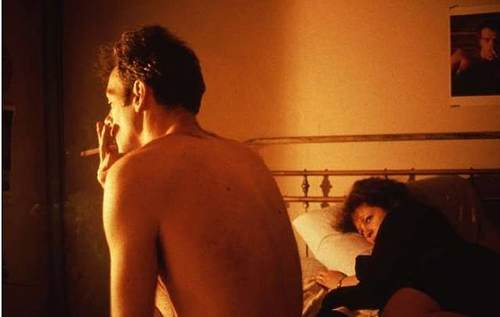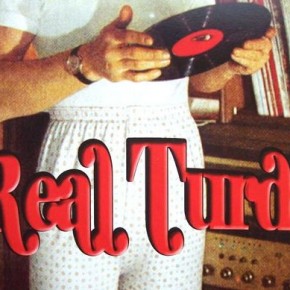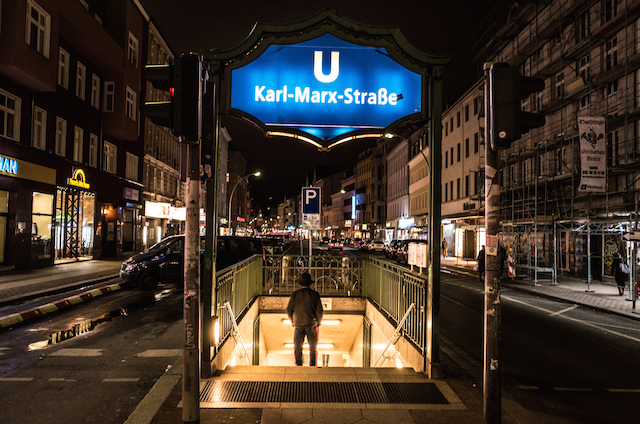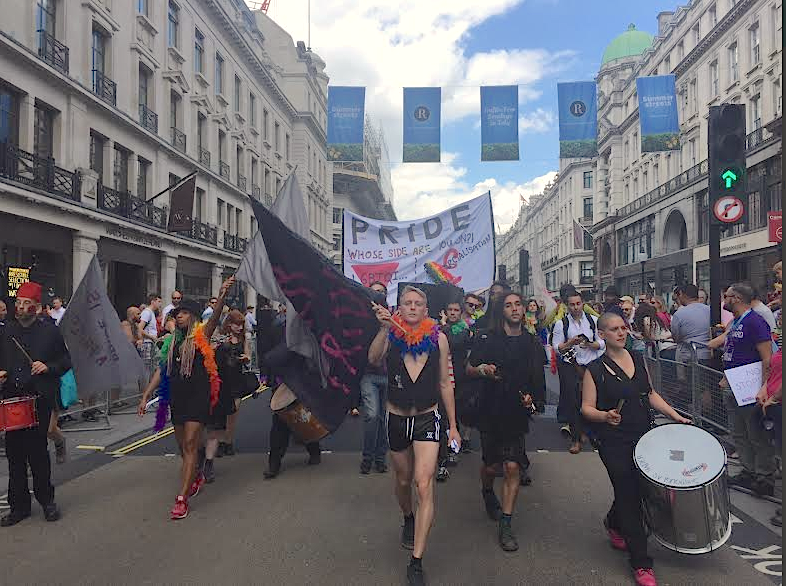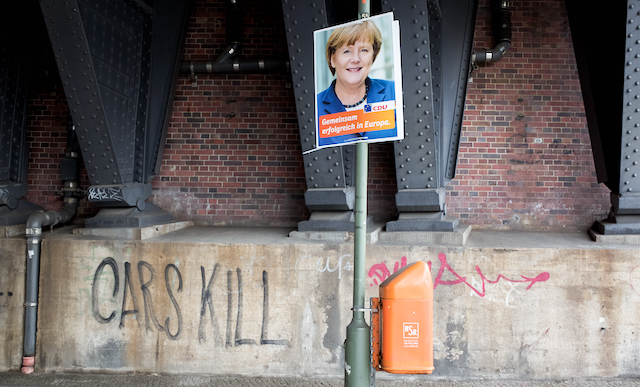Exposed: Voyeurism, Surveillance and the Camera, currently at the Walker Center for the Arts in Minneapolis, pulls together a terrific collection of photos which interrogate the role of the camera in the disintegrating boundaries between the private and the public. This show, which originated at the Tate Modern, raises a lot of provocative questions about the relationship between propriety and photography. When I saw it in the Bay Area earlier this year at the SFMOMA, Nan Goldin’s 45 minute slideshow of her Ballad Of Sexual Dependency photos, made an especially powerful impression.
Goldin’s project documents the private lives of her friends in the post-Stonewall New York art scene starting in 1979. Her camera was as intimate a member of the scene as any of the club girls, junkies, transvestites and glam queens that she photographed. She put that community of outsiders under surveillance. But the voyeurism of the Ballad of Sexual Dependency is not hers — she was part of that community, after all — so much as ours, the museum-goers and readers who get to see her work without having to get to know her subjects.
I first discovered Nan Goldin back in 1981, when I was nineteen years old. I was a kid fresh off the streets, a kid who had spent my teen years in the sex industry and punk scene of San Francisco. I had no high school education and had just begun studying at community college while trying to go “straight.” For some reason I was compelled me to take an interest in art, so I began visiting galleries and learning about artists.
That’s how I found Nan Goldin at the Frankel Gallery. Up until that time in my life, all of my cultural education had come through movies. I watched movies compulsively as a child — all the classic film noirs on television and anything and everything I could see in the movie theater — and Goldin’s photos seemed to be a cinematographic representation of a life that was familiar to me, both from the content of the photos and the way they evoked motion pictures in their form.
I was very influenced by film, because I did not go to high school. I went to the movies. Sometimes I went to the movies two or three times per day. I saw every movie from the 1940s and the 1950s.
— Nan Goldin
On some unconscious level, maybe I was searching for ways to put my experiences of the fringe life of the streets into art and transcend them through art. In any case, I stumbled onto Nan Goldin’s collection in its very early days and I was utterly floored by it. It struck a chord like nothing I’d experienced in a long time, especially since I saw the show within spitting distance of the very streets I had walked as a teenage runaway.
Her photographs of sexual outsiders, junkies, musicians, lovers and drunks sang a familiar song for me. This was a world I knew — a world of sex, drugs, alcohol, violence, and human vulnerability — and Goldin’s portrayal of seemed so beautiful, unflinching, and real. In her photography, I found a kind of mirror of my interior life and all the messed-up history bottled up inside as I tried to navigate my way into the “straight” world.
Of course, later on I would learn that Nan Goldin’s world wasn’t exactly my world. As much as her work was grounded in the alcohol, violence, drugs, sex and death of sexual outsiders in the city, she occupied a position of privilege within that post-Stonewall scene that allowed her to photograph the people in her life, herself included, and promote her work to get early recognition in galleries and museums.
I know she has been criticized for being exploitive and taking advantage of the people in her life, for doing what some consider easy, but these criticisms don’t hold water for me. Just because Goldin had the opportunities to photograph the scene and get her work shown does not mean that her photography doesn’t hold value. I’m damn glad her photos were hanging in the Frankel gallery when I stumbled into it nearly three decades ago. And I’m glad that Goldin continued the project for nearly two decades and eventually assembled it into the slideshow that I saw in San Francisco this year.
Whenever I go back to San Francisco, the city where I was born and the city where I lived on the streets, it’s an intense experience of self-reflection. Seeing Goldin’s slideshow at the SFMOMA allowed me not only to see art the I have admired for many years in a new light — literally, too, as projected transparencies — but also allowed me to further ground myself inside my own personal history of the city and of the subjects in Goldin’s photography.
Accompanied by a music soundtrack and organized into themes (junkies, cross-dressers, drunks, sex, etc.), images Goldin’s audience first got to know through modestly enlarged prints or plates and are now presented in monumental size. I don’t know the actual dimensions, but my guess is that they are about ten feet high. Seeing the photos projected in such large scale was stunning, the subjects captured with such intimate vulnerability and beauty in gorgeously saturated color.
I sat down and gobbled up each image. Bars, trashed apartments, bathrooms, beds and gyms — all of the settings provide the perfect stage as Goldin’s subjects flicker across the wall to the soundtrack. They stare out of the wall in naked human honesty. I was overwhelmed by their beauty and could not stop watching, sitting riveted for the entire 45-minute duration. And I came back to see it two more times in shot succession.
On one viewing, I was with a gay friend who also survived the sex industry and drug addiction. Our shared history of needles, sex work and survival made our experience of Goldin’s slideshow all the more powerful. Both of us were moved to tears by our sense of identification with the stunning and bare beauty of Goldin’s photographs, by our own personal identification and the banks of memory and loss that we carry inside ourselves as survivors.
Seen en masse the photographs in Ballad of Sexual Dependency become an elegy for punk queer art angels who in their “otherness” seem to be stand-ins for the potential of human beauty, not ugliness. Much of the elegiac and angelic quality of the photos is a result of Goldin’s process, shooting color film in available light. The images are radiant, the slow exposure allowing the color to seep into the image with intense saturation. There is no flash to distract by washing out highlights. The color is transcendent and luminous.
It’s strange now to think that Nan Goldin originally intended to shoot in black-and-white film and only ended up using color by accident. (“I accidentally used the roll of color film in my camera. I thought it is black and white, but it was color. “) What a blessing that Goldin put that roll of color film in her camera! Through color she composes such tender images of human vulnerability even when that tenderness is filtered through drugs, sex, violence and death.
This brings me to the comparison that many have made between Nan Goldin and Diane Arbus. Certainly there is similarity in their photographic subjects. Arbus photographs “freaks” in their environs and so does Goldin. But their work is starkly different in what it delivers. Arbus’s freaks are put on display and encased in her cool formal style. There is no sympathy or vulnerability. They are presented like specimens for us to gawk at as they gawk back, the pristine black and white formal composition of her photos functioning almost like display cases for a lab presentation. Her subjects stare out of the frame, imprisoned by the frame like animals on exhibit.
On the other hand, Goldin’s figures explode out of the frame in super saturated color and vitality. They are open and vulnerable. They ask us to recognize their beauty and humanity:
The drag queens hated the work of Arbus. It was not allowed in the house, because they hated the way she photographed drag queens. She tried to strip them of their identity. She did not respect the way they wanted to be. Arbus is a genius, but her work is about herself. Every picture is about herself. It is never respecting the way the other person is. It is almost a psychotic need to try to find another identity, so I think that Arbus tries on the skin of other people. I have written a lot about Arbus.
— Nan Goldin
To be sure, the difference between Goldin and Arbus is a result of style and process. Both photographers make choices to determine the outcome of their work. Arbus’s work is formal, almost clinical in its composed formality. Goldin’s work, by contrast, has a spontaneous feel, like she’s capturing the human spirit emanating from the lights of clubs, apartments, hotel rooms, and streets. Her images are like snapshots of the human spirit, and their humanity cannot be denied. The blurriness of her images from shooting slow camera speed in low light also adds to the angelic effect of Goldin’s subjects.
It’s important to acknowledge that both bodies of work were executed with the intention of eliciting a certain emotional response from the viewer. Goldin’s offer identification, and in their naked vulnerability, they ask us not to cast judgment but to recognize beauty. Arbus’s work also asks us to recognize beauty, but it’s beauty that comes from the formal compositions of her human subjects, the beauty of the exquisite formality of her process over the beauty of the subjects themselves. Arbus takes the “botched” beauty of midgets, giants, twins, transsexuals and others and binds them within a structured formality that is meant to offer artistic redemption. Still, it’s important to remember that despite the difference in the underlying “emotional” content of Goldin and Arbus’s work, both photographers are artists making distinct choices to deliver a certain impact.
Many critics accuse Goldin’s work of being “easy.” Maybe it is easy, carrying her camera around with her and snapping photos while living in the post-Stonewall underground. But just because something is easy does not mean that it’s not valid. There’s merit in doing what it takes to record the rhythm of everyday life, however “easy” that may be, because today’s snapshot could become tomorrow’s historical artifact.
Goldin’s work holds great importance today for documenting the cultural history of a world that barely survives. The underground life her photographs depicts, queer in many senses, most likely could not be recreated today in the 21st century. Post-AIDS epidemic and post-Bush 1 and 2 presidencies, there is not much fringe culture of that sort left to document. That time is over.
What queer culture has survived into this new century has simultaneously assimilated the codes of mainstream America while also being contained and rejected by it. The tension between acceptance and rejection within queer culture and the fact that so many transgressive queers were wiped off the planet with AIDS transformed Goldin’s photographs into a remarkable historical treasure. That’s why it makes sense to see them enlarged larger than life in a slideshow. What once seemed disposable and easy is now endangered and sometimes very, very hard to look at:
It is about keeping a record of the lives I lost, so they cannot be completely obliterated from memory. My work is mostly about memory. It is very important to me that everybody that I have been close to in my life I make photographs of them. The people are gone, like Cookie, who is very important to me, but there is still a series of pictures showing how complex she was. Because these pictures are not about statistics, about showing people die, but it is all about individual lives. In the case of New York, the most creative and freest souls in the city died. New York is not New York anymore. I’ve lost it and I miss it. They were dying because of AIDS.
— Nan Goldin
For my friend and me, looking at Goldin’s slideshow was an intensely emotional experience since we had both survived the culture depicted. I was literally living on the streets in 1979. The world of sex, drugs, violence and queer punk culture in Goldin’s photography was the world I occupied inside the bathroom at San Francisco’s famed Mabuhay Gardens, the place I’d go to lose myself in the droning sounds of early punk throbbing from the stage. The photos of junkies shooting up was the world of my body as I walked the streets to get my next fix. I was a toxic cocktail in the late 70s and early 80s just like Goldin’s cast of characters.
My friend also survived heroin, sex work, and being queer, and lived to tell the story. We both sat in front of the slides and were transfixed by the images that played before us, thinking about all the people we used to know who are now dead while we felt the burden of being survivors. We recognized the beauty in Goldin’s work while also reflecting on our own personal relationship to the subjects.
Seeing the slideshow in San Francisco, just city blocks away from the very streets I walked as a teenager and the residential hotels where I shot dope with the community of junkies, provided me with another kind of “coming home” and closure in my life. It allowed me to remember that surviving what I survived didn’t mark me as a “loser” but rather a survivor who was able to take those experiences and formulate them into art and writing, just like I’m doing here.
If I had not seen Goldin’s photos at the SFMOMA, I wouldn’t have remembered that nineteen-year-old girl fresh off the streets who for some reason took an interest in art. I still haven’t figured out what it was that made me go fresh from the streets to visiting galleries and museums and spending my entire adult life making art and writing. Maybe visiting galleries was one of my early steps to reclaim my home — many of them in San Francisco were on the same streets where I had worked — and taking up art and writing was an unconscious way for me to process my experiences. Certainly seeing Nan Goldin’s Ballad of Sexual Dependency back in 1981 was a major influence on where I would eventually go with my own art and writing. Goldin’s work gave me a window to see how I could put my own experiences into some kind of creative form. Through Goldin’s work, we are reminded that beautiful things can come from ugly experiences, and that is something we all need to remember.
Nan Goldin quotes from “Interview With Nan Goldin” in FotoTapeta.
Nan Goldin’s Ballad of Sexual Dependency is showing at the Walker Art Center in Minneapolis now through October 16, 2011.
